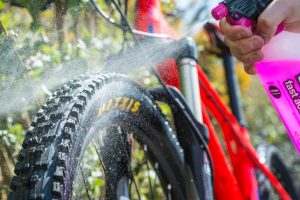Cleaning Your Bike is an Absolute Necessity This Winter
Although it might sound like a painstaking chore, properly maintaining and cleaning your bike should be your first priority when returning from a ride.
This is particularly relevant as the weather turns colder and wet, and the terrains become increasingly damaging to the various components on your bike. While road cycling enthusiasts will mostly stick to the asphalt, the importance of cleaning your gear is just as pressing as those who carve out a more adventurous route on a mountain bike.

Prolonging The Life of Your Kit
The often unpredictable and changeable weather conditions that the UK is faced with during the autumn and winter means that your bike is under threat from increased moisture, as well as loose grit and mud that all combine to form hugely erosive conditions.
Therefore, regularly cleaning your bike, preferably after every ride, can significantly boost the life of the main components. Most notably the drivetrain, which consists of your pedals, cranks, chainrings, chain, cassette and derailleur, are not only key to the proper functioning of the way the bike moves, but they are also directly in the firing line when it comes to loose terrain.
A drivetrain covered in grime and dirt will create additional friction, thus slowing you down and preventing you from reaching your competitive goals.
https://www.youtube.com/watch?v=5ak4AzlUz5Q
Top Tips for Cleaning Process
– Start by rinsing the frame with warm water (a sponge and a bucket is the best way to do this). Avoid using a high-pressured hose as this could loosen bearings and smaller components.
– We recommend you use a chain cleaning machine and some citrus de-greaser or drivetrain cleaner to scrub your chain, then spray or brush some more onto the other oily parts of your bike like the cassette and derailleurs. Once the dirt has gone, rinse your chain and making sure you’ve gotten rid of all the de-greaser. This is the most essential part of the process; the cleaner your drivetrain, the smoother your bike will be to ride.
– Once you’ve cleaned your bike, dry it with a clean rag or microfiber cloth. This will keep water from sitting in areas and causing rust. Focus on trouble areas like bolt heads where it could lead to largely unseen pockets of rust.
– If you live in a rainy environment or frequently ride on wet (everyone in the UK!) muddy trails, go for a wet chain lube. It’s thicker, so heavy downpours and mud won’t wash it away.
-To lube the chain, with the bike stood vertically, turn the pedals backwards with one hand while using the other to drip the lube into the inside of your chain’s rollers. To finish, wipe up any excess lubricant.
































